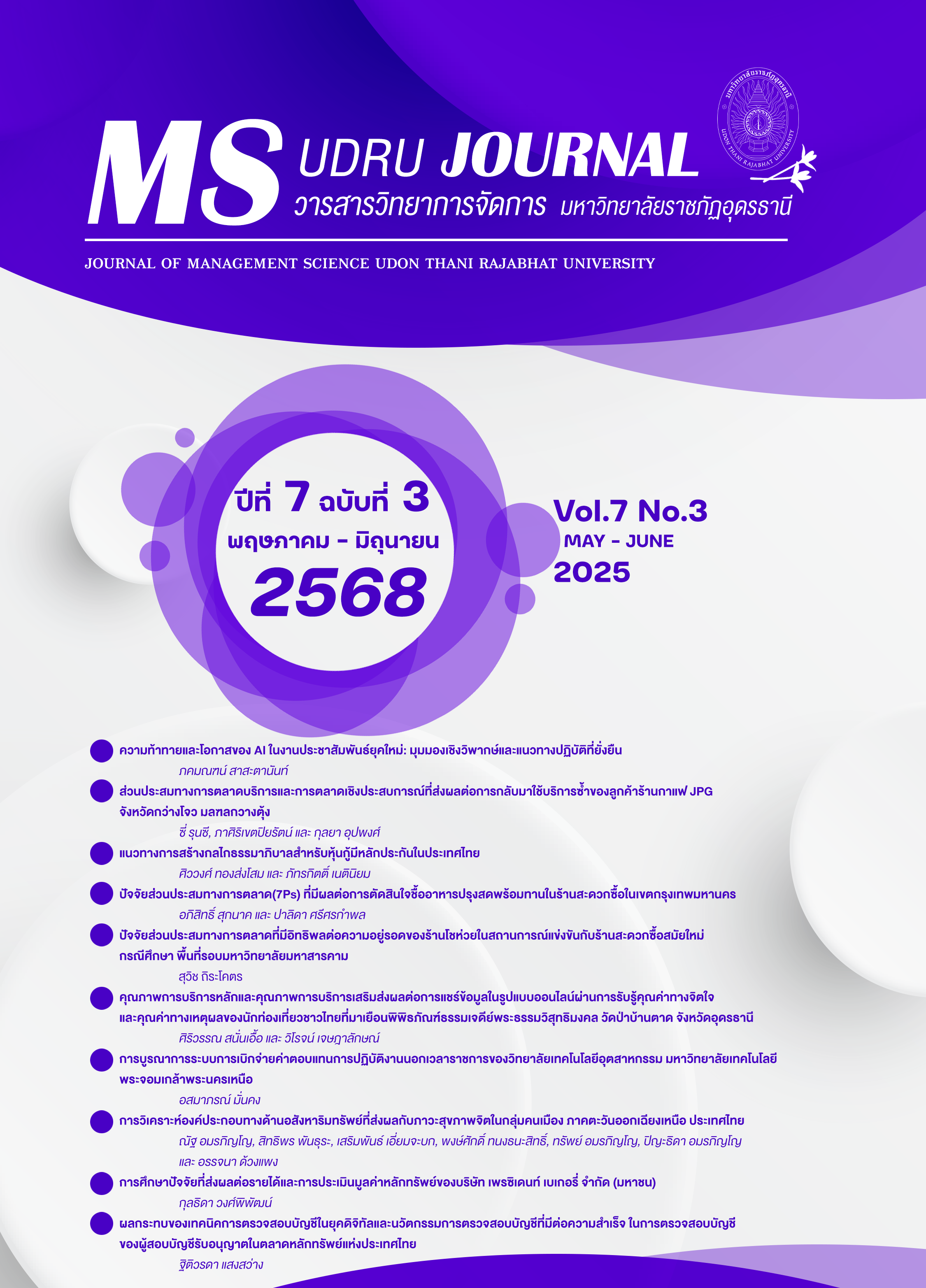MARKETING MIX FACTORS AFFECTING THE SURVIVAL OF GROCERY STORES IN COMPETITIVE SITUATIONS WITH MODERN CONVENIENCE STORES: A CASE STUDY OF AREAS AROUND MAHASARAKHAM UNIVERSITY
Main Article Content
Abstract
The objectives of this research were (1) to study the current state of grocery stores in the area around Mahasarakham University (2) to study the marketing mix factors that influence the survival of grocery stores in competition with convenience stores, and (3) to study the perspectives of grocery store entrepreneurs on the survival of their businesses in the current situation. This research is a quantitative research. Data were collected from 39 grocery store entrepreneurs in areas surrounding Mahasarakham University with a developed questionnaire. Data were analyzed by frequency, percentage, mean and standard deviation. The results of the research revealed that (1) most grocery stores have been in operation for more than 10 years, located on main roads and people’s thoroughfares. Most shops located in the area of the owner's house or private building. The impact of stores when convenience stores were added to the area makes almost grocery stores have no increase in revenue from the original. (2) All aspects of the marketing mix moderately affect the survival of grocery stores, ranked in order of influence from highest to lowest as follows: a diverse range of products, location and distribution channels, marketing promotion, and prices equal to or lower than competitors. (3) Grocery store owners have opinions on the survival of stores in the competitive situation with modern convenience stores, indicated that stores must maintain regular customers with friendliness, and build confidence in customers' stores.
Article Details

This work is licensed under a Creative Commons Attribution-NonCommercial-NoDerivatives 4.0 International License.
บทความที่ได้รับการตีพิมพ์เป็นลิขสิทธิ์ของคณะวิทยาการจัดการ มหาวิทยาลัยราชภัฏอุดรธานี
ข้อความที่ปรากฏในบทความแต่ละเรื่องในวารสารวิชาการเล่มนี้ ไม่ใช่ความคิดเห็นและความรับผิดชอบของผู้จัดทำ บรรณาธิการ กองบรรณาธิการ และคณะวิทยาการจัดการ มหาวิทยาลัยราชภัฏอุดรธานี ความรับผิดชอบด้านเนื้อหาและการตรวจร่างบทความแต่ละเรื่องเป็นความคิดเห็นของผู้เขียนบทความแต่ละท่าน
References
กฤตินี พงษ์ธนเลิศ และคณะ. (2560). เพศ ช่วงวัยและรูปแบบการตัดสินใจซื้อสินค้าของผู้บริโภคชาวไทย. จุฬาลงกรณ์ธุรกิจปริทัศน์, 39(154), 127 – 164.
กาญจนาพร ศิลารังสี และพัทธ์พสุตม์ สาธุนุวัฒน์. (2565). พฤติกรรมผู้บริโภคที่มีต่อความผูกพันร้านโชห่วยในเขตพื้นที่อำเภอบางไทรจังหวัดพระนครศรีอยุธยา. วารสารวิทยาการจัดการปริทัศน์, 24(2), 103 - 116.
ครองขวัญ รอดหมวน. (2561). พฤติกรรมผู้บริโภคยุคใหม่ [ออนไลน์]. สืบค้นเมื่อ 8 มีนาคม 2566 จาก https://www.thaipost.net/main/detail/15886
จิราพร เมืองพงษา. (2557). กลยุทธ์ทางการตลาดของผู้ประกอบการโชห่วยในกรุงเทพมหานคร [วิทยานิพนธ์ปริญญาบริหารธุรกิจมหาบัณฑิต, มหาวิทยาลัยเทคโนโลยีราชมงคลธัญบุรี]. http://www.repository.rmutt.ac.th/dspace/handle/123456789/2633
ฉัตรชัย ตั้งทรัพย์ และสืบชาติ อันทะไชย. (2563). ปัจจัยที่มีอิทธิพลต่อความพึงพอใจและความจงรักภักดีของลูกค้าในการใช้บริการร้านค้าปลีกแบบดั้งเดิมในเขตเทศบาลเมืองหนองคาย. วารสารวิชาการ RMUTT Global Business and Economics Review, 15(2), 19 – 32.
ฉันทัส เพียรธรรม และวันทาพร รุ่งวรรณรัตน์. (2555). การปรับตัวของร้านโชห่วยภายใต้กระแสการขยายยตัวของร้านสะดวกซื้อสมัยใหม่. วารสารการจัดการสิ่งแวดล้อม, 8(1), 39 – 55.
บุญศรี พรหมมาพันธุ์. (2561). การวิเคราะห์ข้อมูลงานวิจัย [ออนไลน์]. สืบค้นเมื่อ 28 กุมภาพันธ์ 2566 จาก https://adacstou.wixsite.com/adacstou/single-post/2018/05/16การว-เคราะห-ข-อม-ลงานว-จ-ย?fbclid=IwAR2ZcoMKYRem_tE87Q4FWIIEVE4i9LHlb8GJZXNuf1YrlJoHJ6oZvgNYqCg
มณีวรรณ บรรลุศิลป์ และปรางทิพย์ เสยกระโทก. (2561). ปัจจัยที่มีอิทธิพลต่อการตัดสินใจเลือกซื้อสินค้าในร้านค้าปลีกดั้งเดิม (ร้านโชห่วย). วารสารวิชาการและวิจัย มหาวิทยาลัยภาคตะวันออกเฉียงเหนือ, 8(2), 1 – 15.
มีเดียน จูมะ. (2563). ทฤษฎีความอยู่รอด (survival) ในมิติผู้ประกอบการ [ออนไลน์]. สืบค้นเมื่อ 28 กุมภาพันธ์ 2566 จาก https://pattanieconomy.wordpress.com/2019/06/02/ทฤษฎีความอยู่รอด-survival-ในมิ/
รดา ช่างเพียร. (2565). ศึกษาปัจจัยที่มีอิทธิพลต่อการตัดสินใจซื้อสินค้าจากร้านค้าปลีกแบบดั้งเดิม (โชห่วย) ในจังหวัดชุมพร. วารสารรัฐศาสตร์ มหาวิทยาลัยราชภัฎสวนสุนันทา, 5(2), 160 – 173.
วราพร บุญประสิทธิ์. (2557). แนวทางการบริหารธุรกิจครอบครัวของทายาทธุรกิจเพื่อความอยู่รอดของธุรกิจ [สารนิพนธ์ปริญญาการจัดการมหาบัณฑิต, มหาวิทยาลัยมหิดล]. https://archive.cm.mahidol.ac.th/bitstream/123456789/677/1/TP%20MM.019%202557.pdf
ส่วนบริหารและพัฒนาเทคโนโลยีการทะเบียน. (2565). จำนวนประชากร [ออนไลน์]. สืบค้นเมื่อ 7 มีนาคม 2566 จาก https://stat.bora.dopa.go.th/new_stat/webPage/statByYear.php
สำนักงานนโยบายและยุทธศาสตร์การค้า. (2564). พาณิชย์เผย ร้านโชห่วยยังเป็นที่นิยม ช่วยส่งเสริมเศรษฐกิจชุมชน [ออนไลน์]. สืบค้นเมื่อ 7 มีนาคม 2566 จาก http://www.tpso.moc.go.th/th/node/11371
อักษราภัค ชิตร. (2565). กลยุทธ์การตลาด 4P [ Marketing Mix ] คืออะไร? พร้อมตัวอย่างวิเคราะห์แบบ Step – by – Step [ออนไลน์]. สืบค้นเมื่อ 28 กุมภาพันธ์ 2566 จาก https://contentshifu.com/blog/4p-marketing-mix
NALISA มาร์เก็ตเธียร์. (2564). ร้านสะดวกซื้อ ยิ่งเปิดเยอะ ยิ่งแข่งดุ [ออนไลน์]. สืบค้นเมื่อ 7 มีนาคม 2566 จาก https://marketeeronline.co/archives/209858
Aylott, Russell & Mitchell, and Vincent-Wayne. (1999). An exploratory study of grocery shopping stressors. British Food Journal. 101. 683-700. doi:10.1108/00070709910288883.
Maggie Geuens, Malaika Brengman, and Rosette Jegers. (2001). "An Exploratory Study of Grocery Shopping Motivations". in E - European Advances in Consumer Research Volume 5, eds. Andrea Groeppel-Klien and Frank-Rudolf Esch, Provo, UT : Association for Consumer Research, 135-140.
usitalo, and Outi. (2001). Consumer perceptions of grocery store formats and brands. International Journal of Retail & Distribution Management. 29. 214-225. doi:10.1108/09590550110390995.


